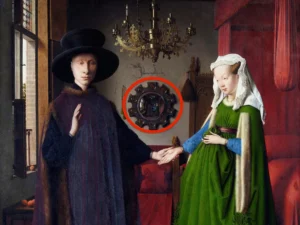Mona Lisa

They say beauty is in the eyes of the beholder, which explains why many art enthusiasts believe that art is open to interpretation. But things aren’t always what they appear to be. In some instances, an art piece of a majestic mountaintop might be just that. But in the case of Da Vinci’s masterpiece, the Mona Lisa, there are secret details hiding in plain sight. Here are the most mysterious secrets hidden in world famous paintings.
Café’s Terrace at Night

Vincent Van Gogh’s 1888 oil painting “Cafe’s Terrace at Night” might appear to be just a café terrace in France, but one expert believes it’s so much more. According to expert Jared Baxter, the painting is Van Gogh’s interpretation of “The Last Supper,” and the central figure in white is Jesus.
The Prophet Zechariah

Michelangelo’s “The Prophet Zechariah” is illustrated in the Sistine Chapel and shows two cherubs glancing over the prophet’s shoulder. But a closer look shows one of the cherubs with their thumb between their index and middle fingers. In those days, this was the equivalent of flipping someone the bird.
The Last Supper

According to Dan Brown’s “The Da Vinci Code,” Leonardo Da Vinci’s “The Last Supper” mural shows Mary Magdalene dressed as John the Apostle. He also indicates that the “V” shape between Jesus and John symbolizes a womb, which suggests that Jesus and Mary Magdalene had a kid. But Giovanni Maria Pala, an Italian computer technician, believes that there are hidden musical notes in the food on the table that contain a 40-second hymn similar to a requiem.
The Arnolfini Portrait

Jan van Eyck’s oil painting, “The Arnolfini Portrait,” shows merchant Giovanni di Nicolao Arnolfini and his wife holding hands. But a look at the mirror in the background shows a reflection of two figures walking into the room, one of whom some claim is van Eyck. But that’s not all.





